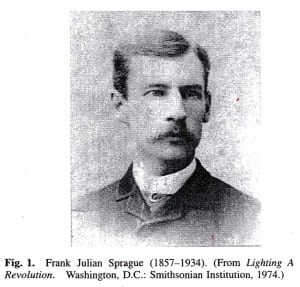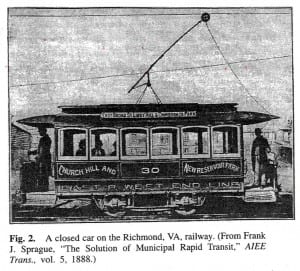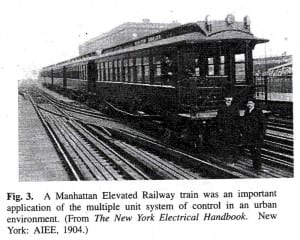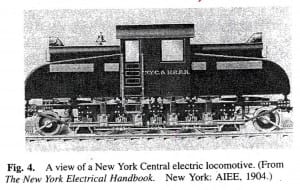Scanning the Past: A History of Electrical Engineering from the Past
Submitted by Marc Bell, Editor
Copyright 1997 IEEE. Reprinted with permission from the IEEE publication, “Scanning the Past” which covers a reprint of an article appearing in the Proceedings of the IEEE Vol. 85, No. 7, July 1997.
Frank J. Sprague and the Electrification of Urban Transportation
Frank J. Sprague (Fig. 1), known for his pioneering contributions to electric traction, electric elevators, and other applications of electric motors, was born 140 years ago this month. In recognition of his achievements in the field of electric power, he received the Edison Medal of the American Institute of Electrical Engineers (AIEE) in 1910. He also served as president of the AIEE during 1892-1893.
electric motors, was born 140 years ago this month. In recognition of his achievements in the field of electric power, he received the Edison Medal of the American Institute of Electrical Engineers (AIEE) in 1910. He also served as president of the AIEE during 1892-1893.
The son of the plant superintendent of a hat factory, Sprague was born in Milford, CT, and graduated from the U.S. Naval Academy in 1878, the same year that the Edison Electric Light Company was incorporated. He served for about two years on a naval ship known as the Richmond and acted as a special correspondent of the Boston Herald while General Ulysses S. Grant spent time on the ship during visits to China and Japan. Subsequently, Sprague served aboard the Lancaster, stationed in the Mediterranean, and installed an electric call bell on the ship. He managed to observe an exhibition of electric lighting systems, including that of Edison, in Paris, France in 1881.
In 1882, Ensign Sprague was granted leave to attend and report on the Crystal Palace Electrical Exhibition in London, England. He served on the awards jury for exhibits of dynamos, electric lights, and gas engines and wrote a 169-page report for the Department of the Navy. His report included a comparison of arc and incandescent lamps and predicted that “the incandescent lamp will generally take the place of the arc lamp.” He praised the Edison lighting system and wrote that Edison “without doubt, has done more than all others, and while his system is by no means yet perfect, it is unquestionably far ahead of the work of anyone else.”
Soon after he completed his report on the Crystal Palace exhibits, Sprague left the Navy to work for Edison. Sprague recognized the commercial potential of direct-current electric motors and designed an exhibit featuring motors for an electrical exhibition in Philadelphia, PA, in 1884. He then left Edison to organize the Sprague Electric Railway and Motor Company, which found a growing market for small motors suitable for driving machine tools, printing presses, and household appliances. By 1889, it was reported that Sprague motors were “to be found in well nigh every city of the Union, to the aggregate of thousands of horsepower.”
In 1887, Sprague contracted to install a 12-mile electric street railway with 40 cars in the city of Richmond, VA (Fig. 2). The Richmond transit system became operational in 1888 and was widely regarded as the prototype for an industry that expanded to about 44000 miles of track by 1917. The success in Richmond led Sprague to present an AIEE paper entitled “The Solution of Municipal Rapid Transit” in June 1888. He stated in his introduction the importance of the transit issue, especially for cities such as New York, and expressed the hope that his paper might precipitate a “general discussion of the subject, not only among electrical men but the general public as well.” He included economic data on existing horse railway systems and also compared his system with cable and steam railway systems. In addition to economic advantages, he wrote that “the riding of an electrical car is far easier than that of any cable or horse car, starting and stopping more easily, and being in a large measure free from lurching and oscillation.” He continued that “there is no dust such as rises from the heels of horses. The sanitary conditions are entirely altered, and the health and comfort of the whole population is conserved. Stables with all their unsavory characteristics and the consequent depreciation of the value of adjacent real estate disappear.”
continued that “there is no dust such as rises from the heels of horses. The sanitary conditions are entirely altered, and the health and comfort of the whole population is conserved. Stables with all their unsavory characteristics and the consequent depreciation of the value of adjacent real estate disappear.”
Fig. 2. A closed car on the Richmond, VA, railway. (From Frank J. Sprague, “The Solution of Municipal Rapid Transit,” A1EE Trans., vol. 5, 1888.)
Sprague continued in his role of innovator through the development of vertical urban transportation in the form of the electric elevator. He organized the Sprague Electric Elevator Company in 1892 after selling his previous company to Edison General Electric in 1890. He installed several hundred elevators before selling the business to the Otis Elevator Company. His work on elevator control led him to invent a multiple-unit control suitable for trains with individually powered cars (Fig. 3). This control system was introduced on the South Side Elevated Railway in Chicago, IL, in 1897. Sprague served on a commission appointed to arrange the electrification of  Grand Central Terminal in New York City during 1903-1908. He remained a strong advocate of direct-current drive for interurban service such as that used by New York Central, which began using electric locomotives in 1906. (Fig. 4) Sprague served as a member of the Naval Consulting Board during World War I. An earlier biographical sketch described him as “keen of glance, restless, and quick of thought and action.”
Grand Central Terminal in New York City during 1903-1908. He remained a strong advocate of direct-current drive for interurban service such as that used by New York Central, which began using electric locomotives in 1906. (Fig. 4) Sprague served as a member of the Naval Consulting Board during World War I. An earlier biographical sketch described him as “keen of glance, restless, and quick of thought and action.”
Fig. 3. A Manhattan Elevated Railway train was an important application of the multiple unit system of control in an urban environment. (From The New York Electrical Handbook. New York: AIEE, 1904.)
It continued that “when taking part in public discussion he is simply the despair of stenographers, and like one of his own motors, maintains the speed no matter how great the load of argument.” Sprague died in 1934 at age 77.
Fig. 4. A view of a New York Central electric locomotive. (From The New York Electrical Handbook. New York: AIEE, 1904.)
James E. Brittain
